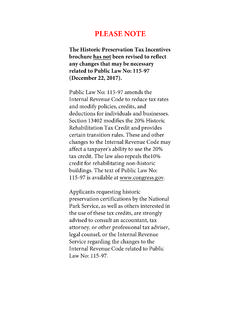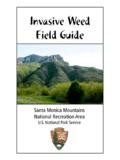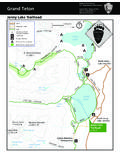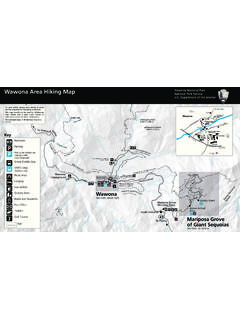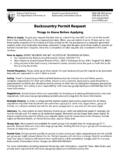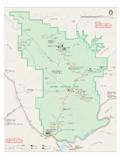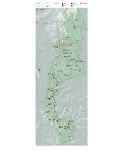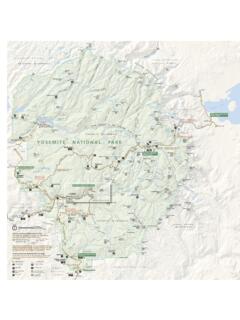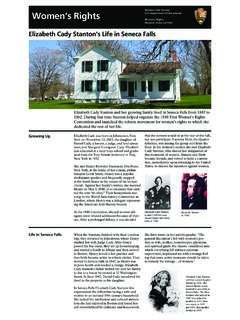Transcription of Sequoia and Kings Canyon - National Park Service
1 Sequoia and Kings Canyon Sequoia and Kings Canyon National Parks California National park Service Department of the Interior From atop Moro Rock you can grasp the multiple superlatives that brought Sequoia and eventually Kings Canyon into the National park System so early that Sequoia is now our second oldest National park . To the north lies the Giant Forest plateau where sequoias rise above their forest neighbors. In cathedral-like Giant Forest stands the 275-foot-tall General Sherman giant Sequoia tree, whose trunk weighs an estimated 1,385 tons and whose circumference at the ground is nearly 103 feet. To the west, in contrast to these gargantuan conifers, are the dry foothills with their oak trees and chaparral vegetation descending toward the San Joaquin Valley. To the south, and down over 5,000 vertical feet, the Middle Fork of the Kaweah River threads its rugged Canyon .
2 To the east snowcapped peaks of the Great Western Divide and the Kaweah Peaks top out on Mount Kaweah at 13,802 feet. Just out of sight beyond the divide the highest mountain in the contiguous 48 states, Mount Whitney, reaches 14,494 feet of elevation. Big trees, high peaks, and deep canyons in North America s longest single continuous mountain range: superlatives abound amidst glorious scenery. Pioneering conservationist John Muir explored and named the Giant Forest. When I entered this sublime wilderness the day was nearly done, he observed, the trees with rosy, glowing countenances seemed to be hushed and thoughtful, as if waiting in conscious religious dependence on the sun, and one naturally walked softly and awestricken among them. May you follow in Muir s footsteps. Earth s Largest Tree In volume of total wood the giant Sequoia stands alone as the largest living tree on Earth.
3 Its nearly conical trunk like a club, not a walking stick shows why. At least one tree species lives longer, one has a greater diameter, three grow taller, but none is larger. In all the world, sequoias grow naturally only on the west slope of the Sierra Nevada, most often between 5,000 and 7,000 feet of elevation. There are some 75 groves in all. The General Sherman Tree is an estimated 2,200 years old. Its largest branch is almost seven feet in diameter. Every year the General Sherman grows enough new wood to make a 60-foot-tall tree of usual proportions. Most of the Sierra trees die of disease, fungi, etc., John Muir wrote, but nothing hurts the Big Tree. Barring accidents, it seems to be immortal. Muir was partly right. Chemicals in the wood and bark provide resistance to insects and fungi, and thick bark insulates them from most fire. The main cause of Sequoia deaths is toppling.
4 They have a shallow root system with no taproot. Soil moisture, root damage, and strong winds can lead to toppling. Sequoia , America s Second Oldest National park San Joaquin Valley residents and others urged Congress to protect Sierra tracts from logging in the 1880s. Some park proponents sought to protect water supplies for irrigation; others, the Big Trees. Preserving land for scenic and recreational values was an infant idea then. Sequoia National park was created on September 25, 1890. A week later Congress tripled its size and created General Grant National park to protect Grant Grove. In 1893 a Sierra Forest Reserve protected more lands, and in 1926 Kern Canyon was added to Sequoia . In 1940 General Grant was merged into the newly-created Kings Canyon National park . In 1978 Mineral king was added to Sequoia . Since 1943 Sequoia and Kings Canyon have been managed jointly.
5 John Muir Conservationist John Muir s response to logging the giant sequoias was: As well sell the rain clouds and the snow and the rivers to be cut up and carried away, if that were possible. Muir explored and named the Giant Forest, site of four of the world s five largest trees. He pioneered Mount Whitney s steep east face. And he proved the geologic role of Sierran glaciers, a new theory then that was disputed by the California state geologist, Josiah D. Whitney. Giant Sequoia Ecology Sequoias don t die of old age and are resistant to fire and insect damage. Most die by falling over. These huge trees sprout from seeds as small and light as oat flakes. Mature trees may yearly produce 2,000 egg-sized cones bearing 400,000 seeds dispersed only as cones open. Cones hang on trees, green and closed, up to 20 years. Douglas squirrels (above) or larvae of a cone-boring beetle may make a few cones open, but fire is the key to seed dispersal and seedbed fertility.
6 It makes the cones dry, open, and drop seeds. It lets sunlight in and burns logs and branches on the forest floor to ashes as fertilizer. Deep Canyons and High Peaks These parks encompass the most rugged portions of the Sierra Nevada. From the highest peaks in the lower 48 states, Ice Age glaciers descended to carve some of the country s deepest canyons. In their upper reaches these gorges show the U-shaped profile characteristic of glacial gouging. At lower elevations they resume the V shape of water-carved canyons. In Sequoia the Generals Highway climbs the stream-cut walls of the Kaweah Canyon . Kings Canyon Scenic Byway passes through both geologic profiles; where it ends, you can stand on Canyon floor scoured flat by glaciers and stare up at Canyon walls rising nearly a mile. Extreme elevation change from 1,500 to 14,494 feet creates a huge variety of habitats.
7 Plants and animals here inhabit life zones ranging from desert heat to arctic cold. This rich diversity stands as one of the values Sequoia and Kings Canyon National Parks preserve for the world. The Snowy, Sawtoothed Mountain Range Over 400 miles long and 60 to 80 miles wide, the Sierra Nevada exceeds the whole Alps area French, Swiss, and Italian. Palisade Crest in Kings Canyon National park and the Mount Whitney group in Sequoia each boast six peaks over 14,000 feet of elevation. No roads cross the range here; intimate appreciations of the mountains scale and grandeur are hard-won afoot or with packstock. Panoramic vistas can be seen from atop Moro Rock; from roadside pullouts along the Generals Highway; from Panoramic Point near Grant Grove; and from roadside pullouts before Kings Canyon Scenic Byway descends into the Canyon . The Mineral king valley provides superlative hiking access to meadows, alpine lakes, and Sierra peaks.
8 Because park roads top out at 7,800 feet of elevation, most people who visit the parks do not experience the alpine country. Above 9,000 feet the harsh climate cannot support tall trees or dense forests. Above about 11,000 feet, no trees grow. Here are mostly boulders, rocks, and gravel punctuated with small alpine lakes, meadows, and low-growing shrubs. Summer flourishes but briefly. Preparing for winter, the marmot stores body fat; the pika stores small piles of hay. Mountain lakes dot Sierran highcountry, many set in cirques, small bowls carved by glaciers. Sierran Wildlife Mule deer are prime prey of elusive mountain lions. Pine martens, fishers, and wolverines pursue squirrels and other small animals. Black bears may take fawns or eat carrion but mostly eat vegetation. Marmots and pikas live in mountains. Coyotes, gray fox, bobcats, and ringtails patrol the foothills.
9 Decades of planting non-native brook, brown, and other trout displaced native rainbow and Little Kern golden trout. Planted fish also diminished amphibian populations, especially frogs. Visiting the Parks Getting HereVehicle access is by Calif. 180 into Kings Canyon or Calif. 198 into Sequoia . The Generals Highway connects both, making loop trips possible. Vehicles longer than 22 feet ( meters) combined length not permitted between Potwisha and Giant ForestMuseum due to road construction. Expect delays. Calif. 180 has fewer curves. There isno road access from 395 on the parks east side. side. Air, bus, Amtrak, and rental cars are available in Fresno and Visalia. Gasoline is not available in the parks. More InformationThe free park newspaper describes park resources and facilities. Call 559-565-3341 for 24-hour recorded information on road and weather conditions (updated daily), camping, lodging, and activities, or to reach a ranger.
10 Or contact: Sequoia and Kings Canyon National Parks47050 Generals Highway Three Rivers, CA 93271-9700 ActivitiesCheck bulletin boards for schedules of ranger-led walks and talks. Crystal CaveThis cool, beautiful cavern is open in summer only. Buy tickets for tours only at Lodgepole and Foothills visitor centers not at the cave. Food and LodgingFor reservations in Kings Canyon year-round, call 559-335-5500. Wuksachi Village Lodge is open year-round in Sequoia ; call 888-252-5757. Grant Grove and Wuksachi offer food Service year-round; Cedar Grove and Lodgepole in summer. Nearby towns offer food and lodging. CampingCampground locations range from the warm foothills to cool forest settings; some are open all year. Only Lodgepole and dorst creek accept reservations for summer; call 877-444-6777 or visit The Lodgepole, Grant Grove, and Atwell Mill campgrounds are close to sequoias.
